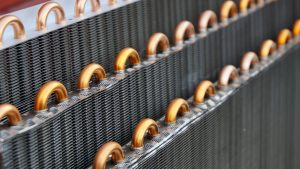 Over the last several decades, heat exchangers have become popular electrical cooling solutions for several different reasons. On one hand, their performance speaks for itself, giving companies the ability to keep their technologies properly cooled at significantly lower costs and much higher efficiency. On the other hand, designing, creating, and implementing heat exchangers are also much more streamlined processes than they are with more traditional thermal management solutions. Together, their streamlined cooling functions and advanced manufacturing techniques make it easier to design heat exchangers for any given application, and ensure they work optimally the first time around.
Over the last several decades, heat exchangers have become popular electrical cooling solutions for several different reasons. On one hand, their performance speaks for itself, giving companies the ability to keep their technologies properly cooled at significantly lower costs and much higher efficiency. On the other hand, designing, creating, and implementing heat exchangers are also much more streamlined processes than they are with more traditional thermal management solutions. Together, their streamlined cooling functions and advanced manufacturing techniques make it easier to design heat exchangers for any given application, and ensure they work optimally the first time around.
Make cooling part of the initial design
The most effective way to make sure a cooling system works as it’s supposed to is to include it in the application’s initial design. When engineers, thermal management specialists, and manufacturing experts all work together, application designs can include electrical cooling systems that are tailored to the design’s unique performance specifications. This means the heat exchanger or other solution is guaranteed to handle the system’s unique heat dissipation requirements, fit into the allotted physical space within the application, and optimize overall energy usage within the design. With the simplified ways that heat exchangers rapidly transfer waste heat, they’re often the ideal thermal solutions to include in the designs of more advanced applications.
The adaptability of modern thermal solutions
The more complex an electrical cooling system is, the more potential areas of concern there can be during its operation. For example, traditional solutions, like air conditioners, are comprised of hundreds of complicated moving parts and consume expensive (sometimes harmful) chemicals, such as Freon. These parts need to be consistently maintained and often repaired, and the chemical fluids must be frequently refilled, for such solutions to continue to work. However, heat exchangers utilize more natural methods to transfer electrical waste heat, such as natural/forced convection and phase-change cooling. These methods don’t require chemicals or complicated mechanical equipment, which makes heat exchangers a more easily adaptable and customizable method of electrical cooling.
Prototyping solutions for innovative designs
While the inherent features of modern heat exchangers and custom thermal solutions make them more reliable than their more conventional alternatives, their reliability is further enhanced by the technologies and techniques that many manufacturers now employ. For example, in many instances, manufacturers can create rapid, 3D prototypes of heat exchanger components and units to test them in a real-world setting before manufacturing the final design. This allows manufacturers and designers to iron out any discrepancies that can affect the unit’s functionality, helping ensure that it works properly the first time it’s put to use.
For more information about designing thermal management solutions that work the first time, call Noren Thermal Solutions in Taylor, TX, at 866-936-6736.







